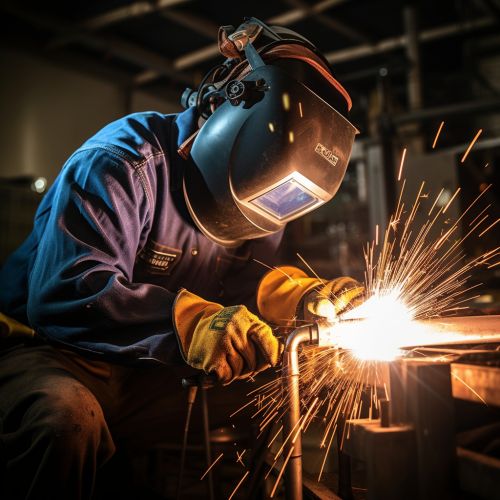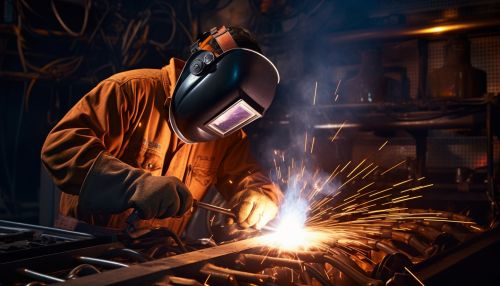Welding
Introduction
Welding is a fabrication process that joins materials, usually metals or thermoplastics, by using high heat to melt the parts together and allowing them to cool, causing fusion. Welding is distinct from lower temperature metal-joining techniques such as brazing and soldering, which do not melt the base metal.
History
The history of welding dates back to the Bronze Age. The earliest examples of welding come from the Bronze Age. Small gold circular boxes were made by pressure welding lap joints together. The Iron Age brought about the discovery of iron and subsequently, the development of blacksmithing.


Types of Welding
There are many types of welding, including but not limited to:
Arc Welding
Arc welding is a welding process that is used to join metal to metal by using electricity to create enough heat to melt metal, and the melted metals when cool result in a binding of the metals.
Gas Welding
Gas welding is a process that melts and joins metals by heating them with a flame caused by a reaction of fuel gas and oxygen.
Resistance Welding
Resistance welding involves the generation of heat by passing current through the resistance caused by the contact between two or more metal surfaces.
Energy Beam Welding
Energy beam welding methods, namely laser beam welding and electron beam welding, are relatively new processes that have become quite popular in high production applications.
Welding Techniques
There are several techniques employed in the act of welding, each with its own set of benefits and drawbacks.
MIG Welding
MIG welding, or metal inert gas welding, is a semi-automatic or automatic process that uses a continuous wire feed as an electrode and an inert or semi-inert gas mixture to protect the weld from contamination.
TIG Welding
TIG welding, or tungsten inert gas welding, uses a non-consumable tungsten electrode to produce the weld.
Stick Welding
Stick welding, or shielded metal arc welding, is a manual arc welding process that uses a consumable electrode covered with a flux to lay the weld.
Safety
Welding, without the proper precautions, can be a dangerous and unhealthy practice. However, with the use of new technology and proper protection, many of the risks of welding can be minimized.
Welding Equipment
Welding equipment varies greatly depending on the process and the materials being welded. The basic equipment, which is necessary for most welding processes, includes a welding machine, electrodes, a welding torch and protective gear.
Applications
Welding is used in many sectors of the economy, from construction to aerospace. It is a critical process in the manufacture of a wide range of products, from cars to skyscrapers to oil rigs.
